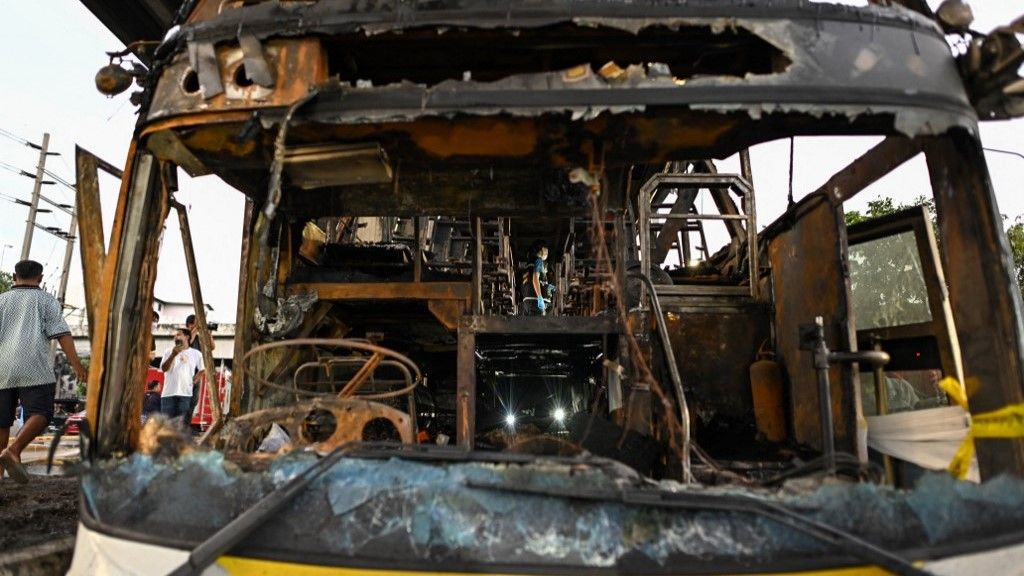Thailand is reeling from a tragic incident, 20 children and three teachers lost their lives in a bus fire three days ago. This is considered one of the worst road accidents in the country. Investigators have discovered several safety lapses that some believe turned the bus into a “bomb on wheels.” As the nation mourns the loss of the 23 individuals on board, many are left wondering how such a tragedy occurred and if it could happen again.
A video captured a bus crashing into a concrete barrier and catching fire, making it impossible for rear passengers to escape. Investigators discovered that the bus, which had been converted to run on compressed natural gas (CNG), had six legally installed gas cylinders in the rear, but they also found five more illegally fitted under the front of the bus. The investigation revealed that a pipe from one of the illegally installed cylinders broke upon impact, causing a gas leak that ignited the fire. It was unclear why the trapped passengers were unable to open the rear emergency exit.
In response, the government ordered over 13,000 public and private CNG-powered buses to undergo inspection and suspended all long-distance school bus trips. The bus had undergone numerous modifications since its initial registration in 1970, with new bodywork added multiple times and only parts of the original chassis remaining. Originally a double-decker, the bus was converted into a single-decker due to height limitations imposed by new regulations. Despite this, passengers were still seated on the upper deck while the lower deck was used to house the gas cylinders. Social media users have likened the bus to a “bomb on wheels.”

Despite Thailand’s gradual introduction of regulations for bus safety over the past 15 years, as laid out by the UNECE (the UN Economic Commission for Europe), the implementation of these rules has been slow and incomplete. According to Sumet Ongkittikul, a transport specialist at the Thailand Development Research Institute, most manufacturers in Thailand cannot meet the required safety standards, leading to delays in implementation to allow them to catch up. Additionally, the regulations only apply to new buses, while the majority of buses in Thailand are old. This is because many buses are modified using old chassis and new bodywork, and these modifications are not held to the same safety standards as new vehicles. It is estimated that at least 80% of the buses connecting Thailand’s cities fall into this older, adapted category.
For instance, UNECE regulation UN R118, which mandates the use of non-flammable materials for bus interiors, was officially introduced in Thailand in 2022 but does not apply to buses made before then or buses adapted using older chassis. The use of less flammable materials could have potentially mitigated the bus fire on Tuesday. It is also reported that the ill-fated bus may have violated even the limited regulations that did apply to it. The police found that the bus was inspected in May this year, but they believe the illegal addition of gas cylinders was made after that. Additionally, the owner of the bus company was caught trying to remove improperly installed gas cylinders from five other buses two days after the accident.
As a result of these infractions, the company has had its bus operating license suspended, and the owner has been charged with causing death through negligence, with other criminal charges being considered. The question now is whether this tragic accident will finally prompt a change in Thailand’s road safety record.

The country is currently implementing its fifth National Road Safety Master Plan, but there has been little progress to show for it. For years, it has ranked in the top 10 countries with the highest per capita road fatalities and has even held the second position at times. According to data from the TDRI, an average of 17,914 people died from road accidents per year over the 10-year period leading up to 2023. In comparison, the UK, which has a similar population, has ten times fewer fatalities. Those who travel regularly on Thai roads are familiar with the dangerous behavior exhibited by many drivers. Speeding is common and rarely punished, cars weave in and out of traffic, leaving little margin for error, and commercial vehicles are often overloaded, badly designed, and poorly lit. Furthermore, motorbike riders frequently fail to wear helmets, more so than in neighboring countries. Some attribute the problem to corruption in the police force, while others blame the Buddhist belief in karma, attributing misfortunes like car accidents to bad luck rather than bad habits. Despite graphic posters warning of the dangers of drinking and driving, there has not been a sustained road safety campaign led by any Thai government. Some researchers believe this is due to the fact that most fatalities, particularly those involving motorbikes and public buses, affect lower income groups, rather than the policymakers who typically drive or are driven in high-end cars with high safety levels.




